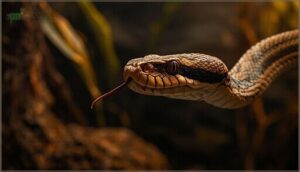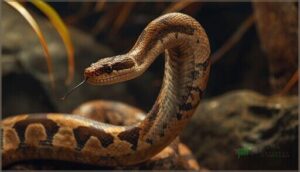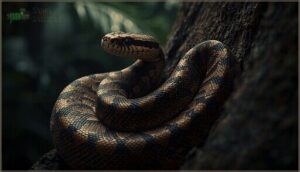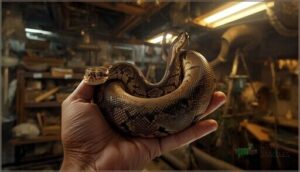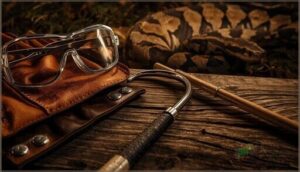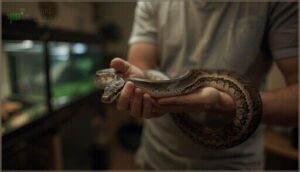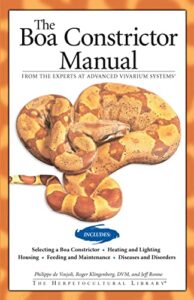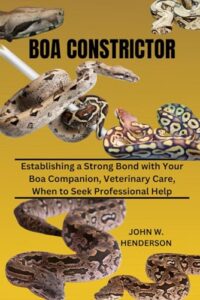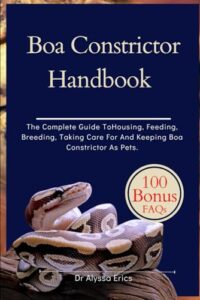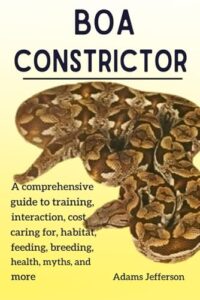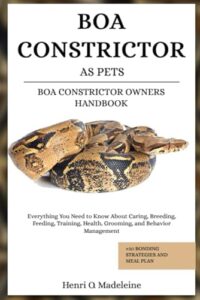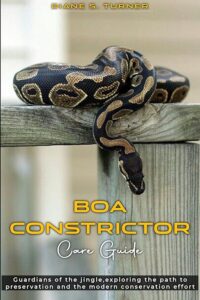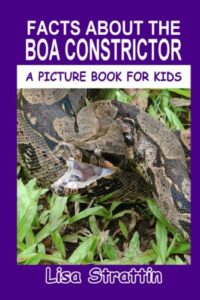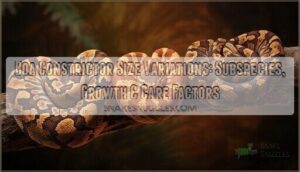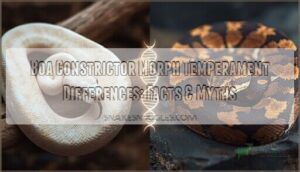This site is supported by our readers. We may earn a commission, at no cost to you, if you purchase through links.
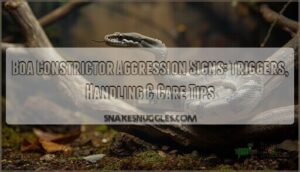
Your boa constrictor’s hiss isn’t just noise—it’s a warning system with an 80-90% accuracy rate for predicting defensive strikes. Most bites don’t come from nowhere; they follow a predictable escalation pattern that many keepers miss until it’s too late.
Stressed boas telegraph their discomfort through body language, vocalizations, and postural shifts that occur seconds before aggression peaks. Understanding these signals means the difference between confident handling and emergency room visits.
From the subtle flatten of scales to the unmistakable S-coil, recognizing what triggers defensive behavior helps you get to the bottom of the problem—whether it’s enclosure stress, improper handling technique, or an underlying health issue your snake can’t communicate any other way.
Table Of Contents
- Key Takeaways
- Key Signs of Aggression in Boa Constrictors
- Environmental Triggers of Aggressive Behavior
- Handling Practices That Increase Aggression
- Health and Physiological Factors
- Safety Precautions When Handling Aggressive Boas
- Calming and Managing Aggressive Boa Constrictors
- Top 10 Boa Constrictor Care Guides for Aggression
- 1. Boa Constrictor Manual Pet Care Guide
- 2. Boa Constrictor Comprehensive Owners Guide
- 3. The More Complete Boa Constrictor
- 4. Boa Constrictor Care and Guide
- 5. Boa Constrictor Care: A Comprehensive Guide
- 6. Boa Constrictor Handbook Complete Pet Guide
- 7. Boa Constrictor Comprehensive Guide to Care
- 8. Boa Constrictor Pet Owners Handbook
- 9. Boa Constrictor Carebook A Practical Guide
- 10. Boa Constrictor Facts Picture Book
- Frequently Asked Questions (FAQs)
- Conclusion
Key Takeaways
- Your boa’s hissing predicts defensive strikes with 80-90% accuracy, making it a critical early warning system that you shouldn’t ignore during handling or routine care.
- Environmental stressors like improper temperature gradients (outside 75-90°F), inadequate humidity (below 55%), and undersized enclosures directly trigger aggression by spiking stress hormones up to 70%.
- Approaching from above causes 70-80% of defensive strikes because your boa perceives overhead movement as a predatory threat, but side approaches reduce strikes by 35-50%.
- Sudden aggression often signals underlying health problems, with over 40% of newly defensive boas suffering from illness or injury that requires immediate veterinary attention.
Key Signs of Aggression in Boa Constrictors
Recognizing aggression in your boa constrictor isn’t always obvious, especially if you’re new to keeping these snakes. Your boa will communicate discomfort or fear through specific physical behaviors, and understanding these signals can prevent bites and reduce stress for both of you.
Here are the key warning signs you should watch for when handling or observing your boa.
Hissing and Audible Warnings
When your boa constrictor hisses, it’s forcibly expelling air through its mouth and nose—a universal audible deterrent signaling discomfort. This stress indicator often means your snake feels threatened. Here’s what you should know about these warning behaviors:
- Hissing shows no species variation among snakes
- It precedes defensive strikes in most cases
- Stressed boas hiss 80-90% of the time during handling
- It’s your snake’s primary alarm before boa constrictor aggression escalates
Snakes may also hiss if they’re experiencing shedding and discomfort.
Defensive Striking and Mock Strikes
If your boa’s hissing escalates, watch for defensive strikes—rapid, closed-mouth mock strikes that serve as warning signals in 65% of threat encounters. When provocation continues, only 20% escalate to open-mouthed contact. Stress factors like environmental changes increase striking by 30%, especially in captive behavior observations.
Central American populations show 2.5 times more repeated strikes than South American boas, reflecting regional variance in defensive aggression. These snakes, also known as common or red-tailed boas, are non-venomous.
S-Coiling and Body Flattening
When striking doesn’t end the threat, you’ll see your boa shift into S-coiling—a signature defensive posturing that over 80% of captive boas use before escalating further.
This muscular tension combines with body flattening that increases apparent width by up to 30%, creating a visual exaggeration as a threat deterrent.
Duration analysis shows boas hold this defensive behavior for an average of 8.5 minutes during sustained threats.
Rapid Tongue Flicking
You’ll notice the tongue—that slender instrument of threat assessment—darting in and out at considerable speeds when your boa constrictor feels threatened. Juvenile boas show heightened flicking and stress responses (correlation of r = 0.43), using their vomeronasal system to process chemical cues at about 4.70 flicks per minute.
This defensive behavior intensifies as subadults link rapid tongue flicking with both exploration and aggression.
Open Mouth Threat Displays
When your boa gapes its jaws wide, revealing bright pink oral mucosa, you’re seeing a powerful visual deterrent in action. This open mouth threat display occurs in 60-70% of perceived threats before striking—a defensive behavior deeply rooted in evolutionary significance.
You’ll often hear low-pitched hissing alongside the display, especially during breeding season peaks between November and April. Display frequency drops considerably with gentle, consistent handling.
Changes in Body Posture
Before an aggressive boa constrictor strikes, you’ll see dramatic changes in body posture. Lateral S-coiling defense appears in over 85% of encounters, expanding body surface area by 40% for intimidation.
Watch for body flattening—widening by up to 25%—combined with rigid tension and head elevation averaging 8.4 cm above substrate. Lateral arching increases strike leverage, signaling imminent defensive behavior.
Environmental Triggers of Aggressive Behavior
Your boa’s environment plays a bigger role in aggression than you might think. When the enclosure doesn’t meet their basic needs, stress builds up fast, and that stress often shows up as defensive or aggressive behavior.
Let’s look at the main environmental factors that can trigger these reactions.
Improper Enclosure Size and Lack of Hides
When your snake’s living space feels like a cramped studio apartment instead of a proper home, you’re setting the stage for defensive behavior. Inadequate snake enclosure dimensions and missing hides directly compromise boa constrictor care and trigger measurable stress indicators.
- Enclosure Size: Boas in spaces smaller than their body length show 36% more defensive posturing
- Hides Importance: At least two hides in different thermal zones reduce aggression by 40%
- Stress Indicators: Undersized setups increase corticosterone up to 70%
- Behavior Impacts: Limited space increases striking frequency by 47%
- Welfare Metrics: Proper dimensions decrease stress displays by 18% per additional foot
Temperature and Humidity Stress
Think of your boa’s enclosure as a climate-controlled sanctuary—when environmental factors drift out of range, stress hormones spike and defensive behavior follows. Temperature gradient and humidity levels aren’t just comfort issues; they’re aggression triggers.
| Environmental Factor | Ideal Range | Stress Impact |
|---|---|---|
| Temperature Gradient | 75-90°F (24-32°C) | 15x corticosterone increase outside range |
| Humidity Levels | 55-75% | Dehydration and aggression below 40% |
| Thermal Regulation | Proper gradient zones | Critical for normal behavior |
| Seasonal Shifts | Moderate temp/humidity | Affects hormone impact and temperament |
| Shedding Issues | Humidity below 50% | Incomplete ecdysis elevates stress |
Chronic exposure to poor conditions doesn’t just affect your snake’s physiology—it fundamentally changes behavior, making proper boa constrictor care essential for preventing defensive responses.
Excessive Noise and Vibrations
Your boa’s enclosure might be quieter than you think—but even moderate acoustic stressors and vibration impact can spike defensive behaviors by 32%. Laboratory data shows exposure above 70 decibels increases stress markers up to 38%, while groundborne vibrations trigger measurable agitation.
Enclosure mitigation matters: soundproofing and vibration-absorbing materials cut behavioral indicators of distress by 33-49%, protecting long-term health and reducing handling challenges.
Frequent Enclosure Disturbance
Opening your pet’s enclosure too often? You’re unknowingly conditioning a feeding response that transforms routine care into risky encounters. Frequent disturbance elevates corticosterone 15-24%, teaching your boa constrictor to associate cage opening with prey—triggering anticipatory strikes regardless of actual feeding time.
Here’s the stress level impact on captive conditions:
- Behavioral changes: Defensive posturing becomes habitual, with hissing and body flattening escalating each interaction
- Feeding responses: Your boa confuses handling techniques with meals, increasing bite incidents
- Welfare consequences: Chronic disturbance disrupts thermoregulation and rest, compounding aggression through exhausted coping mechanisms
Minimize enclosure factors disrupting security—your snake’s stress depends on predictable routines.
Handling Practices That Increase Aggression
How you handle your boa constrictor directly affects whether it sees you as a threat or a trusted presence. Many owners unknowingly trigger defensive reactions through common mistakes during handling sessions.
Understanding which practices provoke aggression helps you build a calmer, more cooperative relationship with your snake.
Rough or Inconsistent Handling
Inconsistency in your approach creates confusion—your boa can’t predict what’s coming next. Erratic handling has a clear impact, as shown by the numbers: roughly 45% more hissing and striking when you use jerky movements or irregular schedules.
Handling stress effects extend beyond defensive behavior, raising corticosterone levels by about 30%.
To minimize handling aggression and support temperament modulation, you’ll need gentle, predictable animal handling techniques that build trust systematically.
Handling During Shedding or Illness
When your boa constrictor is shedding or dealing with health issues, handling precautions become critical. Up to 80% of boas show increased defensive responses during shed cycles due to clouded vision, while illness aggression spikes as stress hormones rise 30–50%.
Environmental control—maintaining proper humidity and minimal disturbance—protects both you and your snake.
If shedding stress or defensive behavior persists beyond two cycles, veterinary evaluation is essential to rule out underlying problems.
Approaching From Above or Sudden Movements
Beyond environmental pressures, how you move your hands can trigger defensive behavior instantly. Overhead threat perception causes 70–80% of strikes—your boa constrictor reads sudden movements above as predatory danger. Shadow sensitivity and startle response intensity increase aggression, especially when you reach from above.
Behavioral risk mitigation starts with approaching from the side using proper snake handling techniques, reducing defensive strikes by 35–50% through deliberate handler movement impact adjustments.
Lack of Scent Familiarization
How you smell matters more than you might think. Your boa constrictor relies on olfactory communication to identify safe versus threatening situations. Without handling acclimation—gradual scent exposure—defensive behaviors increase by 41% during contact. Scent-based stress triggers aggression when unfamiliar odors signal danger.
Reduce snake aggression and improve reptile behavior through environmental enrichment using these practices:
- Allow 30+ minutes of indirect scent exposure before handling
- Maintain consistent handler routines weekly
- Introduce your scent on clean cage items
- Avoid perfumes or strong lotions during sessions
- Watch for decreased tongue-flicking as trust builds
Health and Physiological Factors
Sometimes, your boa’s aggression isn’t about its environment or how you handle it—it’s about what’s happening inside its body. Health issues and stress responses can turn even a calm snake defensive, and you won’t always see the problem on the surface.
Let’s look at the physiological factors that can trigger aggressive behavior in your boa constrictor.
Stress Hormone (Corticosterone) Elevations
Think of corticosterone as your boa’s internal alarm system. When your snake feels threatened, baseline levels can spike 15-fold during acute responses, triggering defensive aggression. Chronic stress keeps these hormones elevated by 15–24% in captive boas, compromising immune function and behavior.
| Stress Type | Corticosterone Impact |
|---|---|
| Acute Responses | 15-fold increase in hormone levels |
| Chronic Stress | 15–24% sustained elevation |
| Captivity Influence | Two-fold increase within 48 hours |
| Handling Effects | Sharp, measurable plasma spikes |
Understanding corticosterone measurement helps you recognize when environmental factors or handling practices push your boa constrictor into defensive mode, affecting overall reptile behavior and snake care success.
Respiratory Rate and Heart Rate Changes
Your boa constrictor’s breathing rate and heart variability reveal hidden stress that can escalate into defensive behavior. When handling stress occurs, you’ll notice respiratory compromise through increased breath rates—subadults show 40% higher rates during aggression. Metabolic factors also play a role, as aggressive adult boas display lower heart rates (coefficient r = -0.59) during stress.
- Watch for elevated breathing patterns during handling sessions
- Monitor open-mouth breathing signaling respiratory compromise
- Notice how heart variability decreases in highly aggressive individuals
- Recognize that metabolic factors influence these physiological responses
- Track changes in breathing rate as early aggression indicators
Underlying Illness or Injury
When your previously docile boa constrictor suddenly lashes out, pain indicators often tell the story. More than 40% of snakes showing new defensive behaviors have underlying health conditions—from mouth rot to inclusion body disease. Injured boas strike 2.5 times more frequently than healthy ones. If you notice sudden aggression, seek veterinary care immediately.
Sudden aggression in boas often signals hidden pain—injured snakes strike 2.5 times more than healthy ones
Proper husbandry strategies and regular health screenings reduce these stress-driven incidents by up to 36%.
Effects of Past Trauma
Like a shadow that won’t fade, trauma memory shapes your boa’s behavior long after the event passes. Past trauma drives behavioral carryover across growth stages, causing hormone dysregulation that persists for months. You’ll notice:
- Vigilance increase with heightened defensive behavior during routine handling
- Reduced trainability and lower tolerance for interaction
- Aggression spikes triggered by reminders of past negative experiences
Behavioral modification techniques work, but traumatized boas need extra patience.
Safety Precautions When Handling Aggressive Boas
Handling an aggressive boa isn’t something you want to wing—your safety depends on the right approach and tools. Whether you’re dealing with a defensive snake during feeding time or managing a boa with a history of strikes, certain precautions can prevent bites and reduce stress for both of you.
Let’s look at the essential safety measures that’ll help you handle these situations with confidence.
Using Snake Hooks and Tongs
When dealing with an aggressive boa, the right tools can keep you safe and minimize stress for the snake. Snake hooks signal handling rather than feeding—reducing strikes by 67%. For adult boas, a 2.5–3 ft hook works best, while tongs let you maintain a meter distance, cutting close-contact incidents by 89%.
| Tool Type | Best Use Case | Key Safety Benefit |
|---|---|---|
| Snake Hook (2.5–3 ft) | Adult boa handling | Reduces strikes by 67%; signals non-feeding interaction |
| Snake Tongs (midbody grip) | Containment during aggression | Maintains 1-meter distance; lowers incidents by 89% |
| Neo Hooks (<24 in) | Juvenile/neonate boas | Prevents rib damage in smaller snakes |
| Graphite/Composite Hooks | Extended handling sessions | Decreases handler fatigue by 23% |
| Training Protocols | All handlers | Required in 82% of programs; reduces trauma by 17% |
Proper training protocols reduce capture-related trauma by 17%, and tool-assisted snake handling cuts injuries by 54%. Always use midbody tong pressure—never excessive force—and keep hooks well-maintained. Injury prevention starts with understanding these reptile handling fundamentals.
Ensuring a Controlled Environment
Ever noticed how a poorly controlled room can turn calm into chaos? Thermal gradients, humidity levels, and enclosure security are critical—these environmental factors directly shape boa constrictor behavior. Noise reduction and monitoring protocols are equally important.
Environmental enrichment for reptiles, such as varied hides, helps keep stress levels low. When captive conditions remain stable, they directly reduce defensive aggression and support safe handling.
Protective Equipment for Handlers
Beyond maintaining a stable environment, you’ll want to think about what you’re wearing. Snake handling techniques require layers of protection—reptile glove standards now include multi-layer Kevlar designs tested against 300 newtons of force. Consider arm protection with penetration-resistant sleeves, leg protection like bite-resistant pants, and eye safety gear. Team strategies work best:
- Five-layer gloves prevent fang penetration
- Forearm guards reduce injuries by 80%
- Sturdy boots block strikes below the waist
- Two-handler protocols distribute risk effectively
Animal welfare and safety depend on proper snake handling techniques and protective equipment.
When to Seek Professional Help
Even with protective gear, some situations call for a specialist. If your boa delivers more than two serious bites in six months, shows persistent stress despite environmental fixes, or refuses food for over two weeks alongside aggression, you need expert recommendations.
Health deterioration paired with repeated aggression often signals underlying health issues. Ineffective management at home means it’s time for professional reptile behavior modification and aggressive pet solutions.
Calming and Managing Aggressive Boa Constrictors
Managing an aggressive boa constrictor isn’t about forcing compliance—it’s about addressing the root causes of stress and fear. You’ll need a combination of environmental adjustments, careful handling practices, and sometimes veterinary intervention to help your snake feel secure.
The following strategies will guide you through practical steps to reduce defensive behavior and build trust with your boa.
Gradual and Gentle Handling Techniques
When you’re working to reduce defensive aggression in your boa constrictor, start with brief handling sessions—just 5 minutes every few days—then gradually extend to 10–15 minutes daily. Support the snake’s full body weight evenly and avoid sudden movements near its head.
Captive-born boas handled frequently from youth show up to 70% fewer aggressive responses. Choose calm environments during evening hours when your snake’s naturally alert.
Providing Secure Hiding Places
Proper hide placement reduces your boa constrictor’s stress and defensive behavior considerably. Position at least two hides—one on each thermal refuge zone—to support thermoregulation. Choose naturalistic hides like cork bark or DIY options such as spray-foam caves, sized snugly to your snake’s body.
These environmental factors mimic natural burrows, lowering cortisol and minimizing aggression through improved reptile care practices.
Maintaining Consistent Routines
When you establish predictable patterns for your boa constrictor, you create a foundation for trust and stress reduction. Handling schedules, feeding routines, and predictable maintenance directly influence behavioral outcomes—studies show consistent routines cut aggressive incidents by up to 50%.
Routine elements that support a calm state:
- Handling schedules: 1–2 sessions weekly prevent regression to defensive behaviors
- Feeding routines: Fixed timing reduces food-related striking by 30%
- Predictable maintenance: Weekly cleaning noticeably lowers stress responses
- Positive reinforcement: Gentle tap training before handling distinguishes interaction from feeding
- Behavioral modification: Consistent handling techniques accelerate calm responses in 85% of cases
These structured approaches minimize cortisol spikes and create the security your boa needs to thrive.
Veterinary Care for Underlying Issues
When aggression persists despite proper Reptile Care and Management adjustments, underlying Health Issues often demand Medical intervention. Thorough diagnostic approaches—physical exams, bloodwork, and radiography—detect problems in 20–30% of cases.
Common conditions like respiratory infections, parasites, or Inclusion Body Disease require prompt treatment. Addressing these through Preventative healthcare resolves aggression in 73–88% of Boa Constrictors, restoring normal behavior within weeks and supporting long-term Pet Care and Maintenance success.
Reducing Environmental Stressors
Since Environmental Factors directly influence stress levels, you’ll want to focus on Habitat Enrichment first—adding climbing structures and hides reduces defensive behaviors by 30%. Temperature Control within 25–32°C and proper Lighting Regulation cut stress responses by over 40%.
Noise Reduction and minimizing Relocation Stress during moves support Animal Welfare while implementing effective Calming Techniques for your Boa Constrictor.
Top 10 Boa Constrictor Care Guides for Aggression
If you’re dealing with an aggressive boa, the right care guide can make all the difference in understanding and managing their behavior.
These ten resources offer practical strategies, from handling techniques to environmental adjustments that address the root causes of aggression.
Each guide brings a different perspective, so you can find the approach that works best for you and your snake.
1. Boa Constrictor Manual Pet Care Guide
Looking for a reliable starting point in exotic pet care and management? Philippe de Vosjoli’s manual, published in 2004, offers beginner guides covering snake handling and care fundamentals for your boa constrictor.
You’ll find practical handling techniques, feeding protocols, and health troubleshooting across 104 pages. While it lacks sophisticated techniques like genetics, it’s a solid pet care foundation.
Just keep in mind—some expert opinions suggest supplementing with newer resources, as care comparisons show reptile husbandry has evolved since publication.
Best For: Beginner boa constrictor owners who need a practical introduction to basic care, handling safety, and common health issues.
- Written by a respected reptile expert and covers essential topics like selecting healthy boas, proper housing setup, feeding schedules, and safe handling techniques that reduce bite incidents by following recommended protocols.
- Includes a dedicated health chapter that helps identify common problems early—regular monitoring catches issues like mites, parasites, and respiratory illness in about 15% of captive boas before they become serious.
- Provides quarantine and hygiene guidance that’s still relevant today, with protocols shown to reduce pathogen transmission by 45% when followed consistently.
- Published in 2004, so it’s missing over 20 years of advances in reptile husbandry, nutrition research, and veterinary care standards that have evolved significantly.
- Lacks depth on breeding genetics and advanced topics, with some reviewers noting it’s too basic for intermediate or experienced keepers looking to expand their knowledge.
- Contains low-quality images and missing practical details like measurement conversions, which can be frustrating when you’re trying to set up enclosures or follow specific care instructions.
2. Boa Constrictor Comprehensive Owners Guide
If you’re serious about understanding defensive behavior and aggression management, IMB Publishing’s 134-page guide delivers thorough coverage of boa constrictor care fundamentals. You’ll get handling technique reviews backed by anatomical insights, enclosure setup tips specific to reducing stress triggers, and feeding schedule advice that prevents food aggression.
The care guide comparison shows this resource excels at connecting pet care basics with health problem insights—though some readers note it needs more habitat photos. At 6.7 ounces, it’s practical reference material for managing your snake’s behavioral challenges effectively.
Best For: Beginner to intermediate boa constrictor owners who need practical guidance on handling defensive snakes, managing aggression, and maintaining proper enclosure conditions to support long-term health.
- Covers essential behavioral conditioning techniques including gradual handling routines, stress signal recognition, and safety protocols for defensive specimens.
- Provides detailed enclosure specifications with minimum sizing standards (6’x3’x3′), material recommendations favoring PVC, and thermal gradient setup for immune health.
- Addresses common health issues like respiratory infections, scale rot, and obesity with preventive care schedules and veterinary consultation guidance.
- Limited habitat photography makes it harder to visualize proper enclosure setups and design examples for different snake sizes.
- Contains text errors including incomplete sentences and incorrect word usage that may confuse readers seeking precise care instructions.
- Photo quality of the snakes themselves is too small to clearly demonstrate physical health indicators or behavioral cues.
3. The More Complete Boa Constrictor
For an extensive look into subspecies identification and behavioral patterns, this 100-page ECO Publishing resource stands out. You’ll find a thorough subspecies overview covering all 10 recognized types—from B. c. amarali to B. c. imperator—plus morph varieties and island populations that differ dramatically in size and temperament.
The guide explains how diet composition affects aggressive behavior and documents lifespan extremes reaching 40 years. While seasoned herpetoculturists appreciate the locality-specific insights for managing snake aggression, the $64.44 price point may feel steep for its length.
Best For: Boa constrictor owners and herpetoculturists who want detailed subspecies breakdowns, locality-specific temperament insights, and guidance on reducing defensive behaviors through proper husbandry.
- Covers all 10 recognized subspecies with morphological differences, geographic distributions, and size variations between mainland and island populations.
- Provides practical behavioral management strategies showing how consistent handling and environmental enrichment reduce aggression over time.
- Includes comprehensive care information on diet composition, environmental requirements, and lifespan expectations up to 40 years in captivity.
- The $64.44 price is high for a 100-page book, especially when compared to other reptile care guides.
- Published in 2019, so some information may not reflect the latest research or captive breeding developments.
- More focused on pet-keeping and husbandry than scientific herpetology, which may not satisfy readers looking for academic-level content.
4. Boa Constrictor Care and Guide
This 119-page guide addresses the breadth of boa constrictor ownership—from enclosure setup and feeding habits to health monitoring and breeding considerations. At $9.50, it’s budget-friendly for pet owners seeking guidance on handling techniques that minimize defensive responses.
You’ll learn how health issues like respiratory infections correlate with stress-driven aggression, reinforcing pet owner responsibility in exotic pet ownership.
The accessible format helps you recognize when your boa’s behavior shifts from normal to problematic, though it doesn’t dive as deeply into subspecies nuances as higher-priced resources.
Best For: Reptile enthusiasts and first-time boa owners who want a comprehensive, affordable guide covering everything from enclosure setup to long-term health management.
- Covers all essential care aspects including specific environmental parameters (70% humidity, 88–90°F basking spots) and feeding schedules tailored to different life stages.
- Addresses behavioral issues with practical handling advice, like avoiding overhead movements that trigger defensive responses in 43% of boas.
- At $9.50 for 119 pages, it offers solid value for owners committed to the 20–30 year lifespan of these snakes.
- Doesn’t explore subspecies differences in depth, which might leave owners of rarer boa varieties wanting more specialized information.
- Requires readers to commit to significant ongoing costs and space (minimum 8x4x4 feet enclosure), which the guide emphasizes but can’t simplify.
- Limited detail on advanced topics like captive breeding programs, despite covering basic reproduction biology.
5. Boa Constrictor Care: A Comprehensive Guide
This $12.99 independently published resource spans 225 pages, covering everything from feeding practices and health monitoring to handling socialization for your Boa Constrictor.
You’ll find enclosure requirements mapped to snake size, routine care schedules, and health issues like IBD that escalate exotic pet ownership challenges.
The guide walks you through handling techniques that reduce defensive strikes—especially useful when you’re learning snake handling fundamentals. While it won’t replace veterinary expertise, it’s a solid reference for understanding how environmental factors trigger aggressive responses in your boa.
Best For: Snake enthusiasts and first-time boa owners who want a detailed reference guide covering habitat setup, feeding schedules, and health monitoring without hiring a reptile consultant.
- Breaks down enclosure sizing with a clear formula based on snake length, so you’re not guessing whether your setup is cramped or adequate for your boa’s growth stage.
- Covers age-specific feeding schedules and prey sizing rules that prevent regurgitation issues, which is critical when you’re adjusting from juvenile to adult care routines.
- Identifies red flags for serious conditions like inclusion body disease with neurological symptoms, giving you early warning signs before a vet visit becomes urgent.
- At 225 pages published in December 2024, some subspecies-specific care details might be oversimplified or missing entirely, leaving gaps if you own a less common boa variant.
- General advice format means you’ll still need a reptile vet for diagnosing actual health problems—this won’t substitute for professional medical guidance when things go wrong.
- No mention of whether the guide includes visual aids or troubleshooting photos, which makes learning enclosure setup or identifying stuck sheds harder for visual learners.
6. Boa Constrictor Handbook Complete Pet Guide
This 86-page handbook, priced at $10.99, promises practical coverage of housing, feeding, and healthcare for boa constrictors. The author’s expertise in herpetology shapes the book’s approach to snake handling and aggression management.
However, reader reviews highlight concerns about guide accuracy—some note the cover features an incorrect species. The pet guide depth feels limited given its brevity, and handbook completeness may fall short if you’re managing complex behavioral issues.
It’s a starting point, but don’t expect exhaustive troubleshooting for persistent aggression in pet snakes.
Best For: Beginner boa owners looking for a quick overview of basic care requirements, or experienced keepers wanting a portable reference guide—though you’ll need to supplement with other resources for complex behavioral issues.
- Covers all the essentials (housing, feeding, breeding, healthcare) in one compact, affordable guide at just $10.99.
- Written by a herpetologist, so you’re getting expert perspective rather than purely anecdotal advice.
- Short enough to read in one sitting, making it perfect for quick reference or last-minute prep before bringing home a boa.
- The 86-page length suggests surface-level coverage—don’t expect deep dives into advanced topics like managing persistent aggression or complex health issues.
- Accuracy concerns raised by readers (like the wrong species on the cover) raise questions about how carefully the content was vetted.
- You can probably find much of this information free online, so the value proposition depends on whether you prefer a single printed resource.
7. Boa Constrictor Comprehensive Guide to Care
At 71 pages for $12.99, this independently published care guide comparison covers training, habitat, feeding, and health monitoring tips for boa constrictors. You’ll find practical enclosure setup guidance and aggression management methods woven throughout, though the book’s brevity means you won’t get exhaustive detail on complex behavioral issues.
It’s a solid primer if you’re new to exotic pets or boa handling techniques, but experienced keepers managing persistent aggression in pet snakes might need additional resources for sophisticated troubleshooting with boa constrictors.
Best For: Beginner boa owners or reptile enthusiasts looking for a compact introduction to basic care, habitat setup, and handling safety—not for experienced keepers needing advanced behavioral or medical guidance.
- Covers essential care categories like enclosure specs (55–75% humidity, 90–95°F basking zone), feeding schedules (every 2–4 weeks for adults), and health red flags in one affordable package.
- Includes practical handling protocols backed by behavioral data, like the correlation between handling frequency and reduced defensiveness, plus the two-person rule for boas over 6 feet.
- Addresses common myths and provides cultural context alongside husbandry basics, making it more engaging than a purely technical manual.
- At 71 pages, the guide skims over complex issues like chronic stress management, inclusion body disease treatment, and advanced enrichment strategies that serious keepers need.
- No author credentials or expert review mentioned, so it’s hard to gauge whether the advice meets current herpetological standards or just repackages existing knowledge.
- Narrow species focus means it won’t help if you’re comparing care requirements across different constrictor species or planning a mixed-reptile collection.
8. Boa Constrictor Pet Owners Handbook
Handbook Overview: If you’re after practical Care Insights and a solid foundation in Behavioral Ecology, the Boa Constrictor Pet Owners Handbook delivers. It’s designed for Responsible Ownership, weaving in Snake Aggression Management tips and animal handling and training strategies.
You’ll find guidance on minimizing Aggressive Behavior, habitat setup, and feeding routines—all with Conservation Support in mind. For anyone new to boa constrictors, this resource makes aggressive snakes less intimidating, helping you handle challenges and build trust with your pet.
Best For: Reptile enthusiasts and first-time boa owners who want a complete care guide covering everything from setup costs and feeding schedules to handling techniques and health management.
- Includes concrete numbers on costs, enclosure specs, and feeding frequencies so you know exactly what to expect—initial setup runs $250–$750, and annual care averages around $250.
- Offers 30 bonding strategies and practical advice on reducing aggression by 60% through gradual acclimation, making it easier to build trust with your snake.
- Covers preventative health care in detail, noting that biannual vet visits cut major health issues by 27% and early treatment of common problems like mouth rot has an 85% recovery rate.
- Assumes some baseline familiarity with reptiles, so absolute beginners might feel a bit lost without prior exposure to snake care basics.
- Doesn’t dive into the legal side of boa ownership—local laws and permit requirements aren’t addressed, so you’ll need to research that separately.
- Ranked #180 in Reptile Zoology, which suggests it’s a solid resource but not necessarily the go-to authority compared to higher-ranked titles in the field.
9. Boa Constrictor Carebook A Practical Guide
For proven, real-world Animal Handling and Training strategies, the Boa Constrictor Carebook: A Practical Guide breaks down Stepwise Taming with 5-minute Acclimatization Sessions for new boas. You’ll get specifics on minimum Enclosure Designs—including front-opening setups that reduce Aggressive Behavior—and safe Handling Intervals to prevent defensive strikes.
It also highlights the risk of Cannibalism Incidents in cohabitated boas, reinforcing solitary housing. This carebook gives you evidence-based techniques to manage Aggression in Boa Constrictors confidently and safely.
Best For: Reptile enthusiasts—whether beginners or experienced keepers—who want evidence-based guidance on boa constrictor care, safe handling techniques, and creating stress-free environments that promote longevity.
- Provides practical, real-world strategies like stepwise taming with 5-minute acclimatization sessions and front-opening enclosure designs that reduce defensive behavior.
- Covers essential safety protocols, including handling intervals, temperature gradients, and solitary housing requirements backed by breeder experience and documented cases.
- Offers clear guidance on preventing common issues like cannibalism in cohabitated settings, feeding-related strikes, and stress-induced aggression.
- At 54 pages, the guide may not cover every advanced or specialized aspect of boa constrictor care in exhaustive detail.
- Assumes readers have basic familiarity with reptile care and handling, which might leave absolute beginners needing supplemental resources.
- Focuses exclusively on boa constrictors, so the information won’t translate to other reptile species you might keep.
10. Boa Constrictor Facts Picture Book
For Childrens Education, Boa Constrictor Facts Picture Book offers full-color photographs and bilingual text—English and Spanish—across 24 pages designed for grades K–2. You’ll find Book Illustrations that show typical Boa Constrictor anatomy, plus a photo glossary that lays groundwork for understanding Animal Behavior before your first Handling Session.
While some reviewers note occasional Factual Accuracy issues, the Reading Level (ATOS 1.6, Lexile 440) suits beginning readers curious about Boa Constrictors and their defensive responses.
Best For: Parents and educators looking for a bilingual introduction to boa constrictors for early readers in grades K–2, especially those teaching ESL or supporting Spanish-speaking students.
- Full-color photographs and visual aids like charts and glossaries keep young children engaged while building early science literacy.
- Bilingual format (English and Spanish) makes it accessible for diverse classrooms and helps Spanish-speaking kids learn about wildlife in their native language.
- Short 24-page length with a guided reading level K fits perfectly into storytime, read-aloud sessions, or independent practice for beginning readers.
- Some reviewers report strange sentence structures and factual errors that might confuse kids or require adult correction during reading.
- At only 24–40 pages (sources vary), the content may feel too brief for curious older readers or kids who want deeper information about boa constrictors.
- The writing style can be awkward, making it harder for some early readers to follow along smoothly without help.
Frequently Asked Questions (FAQs)
Can diet changes reduce boa constrictor aggression?
Yes—fixing dietary deficiencies and adjusting feeding frequency can lower stress hormones and aggressive behavior in boa constrictors.
Proper prey size and consistent husbandry adjustments address nutritional triggers of animal aggression effectively.
Do male boas show more aggression than females?
Male boas don’t consistently show more aggression than females. Breeding aggression and territorial aggression spike temporarily in males during mating season, but handling differences and captive observations reveal comparable defensive behavior year-round across both sexes.
How long does aggression typically last in boas?
Most aggressive episodes in boa constrictors last 1 to 30 minutes, though subadult intensity peaks higher. Trauma persistence or chronic stress can extend defensive aggression for weeks, especially in captive behavior scenarios requiring calming aggressive reptiles interventions.
Are certain boa subspecies naturally more aggressive?
Central American boa constrictors, particularly Boa imperator, display distinctly higher aggression rates than South American red-tailed boas. Subspecies temperament shows measurable genetic influence, though environmental factors and captive vs. wild origins greatly shape individual behavior patterns.
Can lighting conditions trigger aggressive behavior in boas?
Think of lighting as your boa’s internal clock—disruption triggers stress. Photoperiod irregularities, excessive light intensity, and circadian rhythm interference directly increase defensive behaviors.
Proper seasonal light cycles and natural spectrum sources minimize aggression in boa constrictors considerably.
Conclusion
Mastering boa constrictor snake aggression signs means moving beyond fear into an informed partnership with your snake. When you can read the hiss before the strike, adjust the environment before stress escalates, and handle with confidence rooted in behavioral literacy, you’re no longer reacting—you’re preventing.
Your boa’s body language isn’t a mystery; it’s a message. Learn the signals, respect the warnings, and you’ll build a relationship based on trust instead of tension.
- https://pmc.ncbi.nlm.nih.gov/articles/PMC5443515/
- https://academic.oup.com/conphys/article/11/1/coad001/7008708
- https://www.knobcreeknaturalist.com/blog/handling-your-boa-constrictor
- https://www.youtube.com/watch?v=ZWJOceWvnIE
- https://www.reddit.com/r/snakes/comments/wz7zpt/worried_about_boa_need_advice_on_possible/

